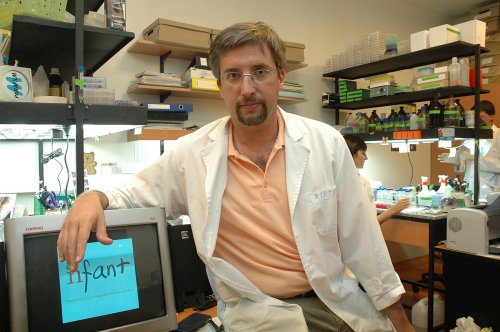
Vanderbilt’s Fernando Polack, M.D., in his lab in Argentina. (photo by Diario Perfil/Juan Obregón)
Breast milk’s ability to fight respiratory viruses investigated
Recent studies by Fernando Polack, M.D., show that the ability of breast milk to protect infants against respiratory viruses is gender-biased in favor of girls.
Polack's first study appeared last June in Pediatrics, and the second came out in February's Pediatric Infectious Disease Journal. The research took place at hospitals in Buenos Aires, Argentina, through Polack's INFANT foundation research facility.
“We were really looking for evidence that breast milk might protect against human metapneumovirus, for which there is no vaccine. But when we saw how significant this difference between boys and girls was, we were a bit surprised,” Polack said.
Polack, recently named the Cesar Milstein Associate Professor of Pediatric Infectious Diseases at the Monroe Carell Jr. Children's Hospital at Vanderbilt, is studying alternatives to protect newborn babies against respiratory viruses, especially very vulnerable premature infants.
He said he knew of anecdotal evidence that suggested a gender difference in the protective effect of breast feeding. There have been a few small studies reinforcing the idea as well, but they have not garnered much attention.
Polack's study in Pediatrics examined the effect in very low-birthweight babies. He found once baby girls left the neonatal intensive care unit, those who were getting breast milk since birth were rarely re-hospitalized for respiratory infections. The big surprise was that girls who were not breast fed were at the highest risk for re-hospitalization, outstripping the risk for boys. The difference between breast-fed boys and non-breastfed boys was not statistically significant.
The most recent study, involving full-term babies, showed roughly the same thing. But beyond describing a thought-provoking difference between boys and girls, Polack says his work brings up the more important question: How does the protection of breast milk work?
“We used to think breast milk was an immune system boost, pre-made from the mother and ready to be used by the baby. But if that were the case, gender should not make a difference. This suggests the protection is in the baby at birth,” Polack said.
Polack said he thinks there is some immune process within babies at birth with the potential to offer “non-specific” antiviral protection.
“At least for girls, breast milk may trigger this protection that is non-specific, protecting against all the viruses we looked at,” and we looked at a dozen or more viruses.”
This points to the potential of discovering a natural human substance, or new immune mechanism that can provide anti-viral protection without having to be exposed to a virus first (the mechanism employed in vaccine development).
“We have been testing vaccines for more than 40 years with the idea that we need a single vaccine for each organism. But today we have no single vaccine for infants under 6 months of age,” Polack said. “Vaccines are very important. But this is evidence that we may have an alternate method we never imagined.”
Polack emphasizes no one should read into this work that breast milk is not beneficial to baby boys. There are numerous other benefits beyond protection from respiratory illness that are not questioned. And Polack said he believes some respiratory protection is there for boys, but more research is needed to show it.













